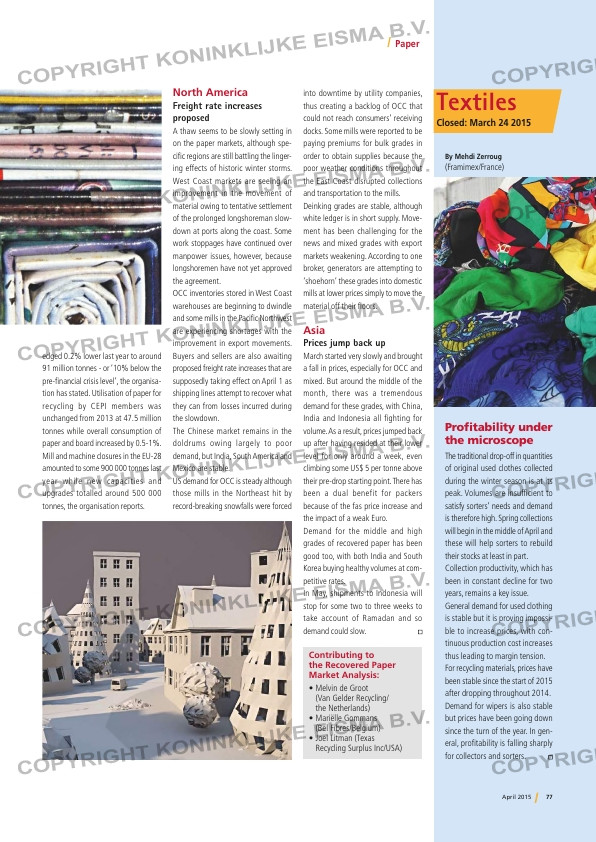Page 77 from: April 2015

Paper
Textiles
Contributing to
the Recovered Paper
Market Analysis:
• Melvin de Groot
(Van Gelder Recycling/
the Netherlands)
• Mariëlle Gommans
(Bel Fibres/Belgium)
• Joel Litman (Texas
Recycling Surplus Inc/USA)
Closed: March 24 2015
77April 2015
edged 0.2% lower last year to around
91 million tonnes – or ‘10% below the
pre-fi nancial crisis level’, the organisa-
tion has stated. Utilisation of paper for
recycling by CEPI members was
unchanged from 2013 at 47.5 million
tonnes while overall consumption of
paper and board increased by 0.5-1%.
Mill and machine closures in the EU-28
amounted to some 900 000 tonnes last
year while new capacities and
upgrades totalled around 500 000
tonnes, the organisation reports.
Profi tability under
the microscope
The traditional drop-off in quantities
of original used clothes collected
during the winter season is at its
peak. Volumes are insuffi cient to
satisfy sorters’ needs and demand
is therefore high. Spring collections
will begin in the middle of April and
these will help sorters to rebuild
their stocks at least in part.
Collection productivity, which has
been in constant decline for two
years, remains a key issue.
General demand for used clothing
is stable but it is proving impossi-
ble to increase prices, with con-
tinuous production cost increases
thus leading to margin tension.
For recycling materials, prices have
been stable since the start of 2015
after dropping throughout 2014.
Demand for wipers is also stable
but prices have been going down
since the turn of the year. In gen-
eral, profi tability is falling sharply
for collectors and sorters.
By Mehdi Zerroug
(Framimex/France)
North America
Freight rate increases
proposed
A thaw seems to be slowly setting in
on the paper markets, although spe-
cifi c regions are still battling the linger-
ing effects of historic winter storms.
West Coast markets are seeing an
improvement in the movement of
material owing to tentative settlement
of the prolonged longshoreman slow-
down at ports along the coast. Some
work stoppages have continued over
manpower issues, however, because
longshoremen have not yet approved
the agreement.
OCC inventories stored in West Coast
warehouses are beginning to dwindle
and some mills in the Pacifi c Northwest
are experiencing shortages with the
improvement in export movements.
Buyers and sellers are also awaiting
proposed freight rate increases that are
supposedly taking effect on April 1 as
shipping lines attempt to recover what
they can from losses incurred during
the slowdown.
The Chinese market remains in the
doldrums owing largely to poor
demand, but India, South America and
Mexico are stable.
US demand for OCC is steady although
those mills in the Northeast hit by
record-breaking snowfalls were forced
into downtime by utility companies,
thus creating a backlog of OCC that
could not reach consumers’ receiving
docks. Some mills were reported to be
paying premiums for bulk grades in
order to obtain supplies because the
poor weather conditions throughout
the East Coast disrupted collections
and transportation to the mills.
Deinking grades are stable, although
white ledger is in short supply. Move-
ment has been challenging for the
news and mixed grades with export
markets weakening. According to one
broker, generators are attempting to
‘shoehorn’ these grades into domestic
mills at lower prices simply to move the
material off their fl oors.
Asia
Prices jump back up
March started very slowly and brought
a fall in prices, especially for OCC and
mixed. But around the middle of the
month, there was a tremendous
demand for these grades, with China,
India and Indonesia all fighting for
volume. As a result, prices jumped back
up after having resided at their lower
level for only around a week, even
climbing some US$ 5 per tonne above
their pre-drop starting point. There has
been a dual benefit for packers
because of the fas price increase and
the impact of a weak Euro.
Demand for the middle and high
grades of recovered paper has been
good too, with both India and South
Korea buying healthy volumes at com-
petitive rates.
In May, shipments to Indonesia will
stop for some two to three weeks to
take account of Ramadan and so
demand could slow.
RI-3 Analysis Paper&Textiles.indd 77 30-03-15 10:04



